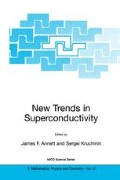Abstract
One of most striking features of high-Tc cuprates consists of an eccentric relationship between Tc and the maximum gap value 2Δ0 at T≪Tc1 particularly, in the underdoped (UD) region; Tc decreases with hole-doping level p while 2Δ0 continues to increase with p, which is in sharp contrast to the BCS result.1-6) This issue seems to be closely related to the development or existence of a pseudo gap (PG) in the normal state. Therefore, to clarify the nature of the PG as well as the superconductivity is very important for understanding the mechanism of the superconductivity in high-Tc cuprates. The PG was first reported as a spin gap (SG) in low- energy spin excitation spectrum in NMR relaxation-time T 1 experiments on underdoped YBa2Cu3O6+ð (Y123).7,8) The SG has been confirmed in the neutron scattering and uniform magnetic susceptibility measurements.9,10)
Access this chapter
Tax calculation will be finalised at checkout
Purchases are for personal use only
Preview
Unable to display preview. Download preview PDF.
References
J. M. Harris et al, Phys. Rev. B 54 (1996) 15665.
M. Oda et al., Physica C 281 (1997) 135.
T. Nakano et al., J. Phys. Soc. Jpn. 67 (1998) 2622.
N. Miyakawa et al., Phys. Rev. Lett, bf 80 (1998) 157.
Ch. Renner et al., Phys. Rev. Lett. 80 (1998) 149.
J. C. Campuzano et al., Phys. Rev. Lett. 83 (1999) 3709.
H. Yasuoka, T. Imai and T. Shimizu, Springer Series in Solid State Science 89, Strong Correlation and Superconductivity, (Springer-Verlag, New York, 1989) p. 254.
W.W. Warren et al., Phys Rev. Lett. 62 (1989) 1193.
J. Rossat-Mignod et al., Physica C 185-189 (1991) 86.
H. Alloul, T. Ohno, T. Tewrdt, Phys. Rev. Lett. 63 (1989) 1700.
S. Uchida, Jpn. J. Appl. Phys., 32 (1993) 3784.
J. W. Loram et al., Phys. Rev. Lett., 71 (1993) 1740.
A. G. Loeser et al., Science 273 (1996) 325.
H. Ding et al., Nature 383 (1996) 51.
A. Matsuda, etal., Phys. Rev. B 60 (1999) 1377.
V. M. Krasnov etal. Phys. Rev. Lett. 84 (2000) 5860.
M. Suzuki and T. Watanabe, Phys. Rev. Lett, in press.
A. Ino etal Phys. Rev. Lett., 81 (1998) 2124.
T. Sato et al., Physica C 341-348 (2000) 815.
D. C. Johnston, Phys. Rev. Lett. 62 (1989) 957.
M. Oda, H. Matsuki and M. Ido, Solid State Commun. 74 (1990) 1321.
H. Takagi et al., Phys. Rev. B 40 (1989) 2254.
T. Nakano et al., Phys. Rev. B 49 (1994) 16000.
T. Nishikawa, J. Takeda and M. Sato, J. Phys. Soc. Jpn. 63 (1994) 1441
H. Y. Hwang etal., Phys. Rev. Lett. 72 (1994) 2636.
W. A. Groen, D. M. de Leeuw and L. F. Feiner, Physica C 165 (1990) 55.
R. M. Dipasupil et al., Physica C, in press.
N. Momono et al., Physica C 341-348 (2000) 909.
N. Momono et al., J. Low. Tern. Phys., 117 (1999) 353.
T. Nakano et al., J. Phys. Soc. Jpn., 67 (1998) 2622.
C. Manabe, M. Oda, and M. Ido, J. Phys. Soc. Jpn., 66 (1997) 1776.
Z.-X. Shen and J. R Schrieffer, Phys. Rev. Lett. 78 (1997) 1771.
N. Momono and M. Ido, Physica C 264 (1996) 311.
M. Suzuki and T. Watanabe, Phys. Rev. Lett. 85 (2000) 4787.
R. E. Walstedt et al., Phys. Rev. B 44 (1991) 7760.
K. Ishida et al., Phys. Rev. B 58 (1998) 5960.
F. J. Ohkawa, J. Phys. Soc. Jpn. 56 (1987) 2267.
H. Won and K. Maki, Phys. Rev. B 49 (1994), 1397.
Tanamoto et al., J. Phys. Soc. Jpn. 61 (1992) 1886.
S-S Lee and S-H S. Salk, submitted to Phys. Rev. Lett.
V. J. Emery and S. A. Kivelson, Nature 374 (1995) 434.
Y. Yanase and K. Yamada, Phys. Soc. Jpn. 68 (1999) 2999.
T. H. Gimm and S. S. Salk, Phys. Rev. B 60 (1999) 6324.
M. Ido, N. Momono and M. Oda, J. Low Temp. Phys., 117 (1999), 329
M. Oda et.al. J. Phys. Soc. Jpn., 69 (2000) 983.
R. Nemetschek et al., Phys. Rev. Lett. 78 (1997) 1771.
G. Deutscher, Nature 387 (1999) 410.
H. Ding et al., cond-mat/0006143.
24. P. A. Lee and X. G. Wen, Phys. Rev. Lett. 78 (1997) 4111.
X. G. Wen and P. A. Lee, Phys. Rev. Lett. 80 (1998) 2193.
V. B. Geshkenbein etal., Phys. Rev. B 55 (1997) 3173.
M. R. Norman etal.: Nature 392 (1998) 157.
Y. Yanase and K. Yamada, Phys. Soc. Jpn. 68 (1999) 548.
Y. Uemura et al, Phys. Rev. Lett. 62 (1989) 2317; ibid. 66 (1991) 2665.
Author information
Authors and Affiliations
Editor information
Editors and Affiliations
Rights and permissions
Copyright information
© 2002 Springer Science+Business Media Dordrecht
About this chapter
Cite this chapter
Oda, M., Momono, N., Ido, M. (2002). Correlation Between Superconducting Gap and Pseudogap in High-T C Cuprates. In: Annett, J.F., Kruchinin, S. (eds) New Trends in Superconductivity. NATO Science Series, vol 67. Springer, Dordrecht. https://doi.org/10.1007/978-94-010-0544-9_16
Download citation
DOI: https://doi.org/10.1007/978-94-010-0544-9_16
Publisher Name: Springer, Dordrecht
Print ISBN: 978-1-4020-0705-7
Online ISBN: 978-94-010-0544-9
eBook Packages: Springer Book Archive

